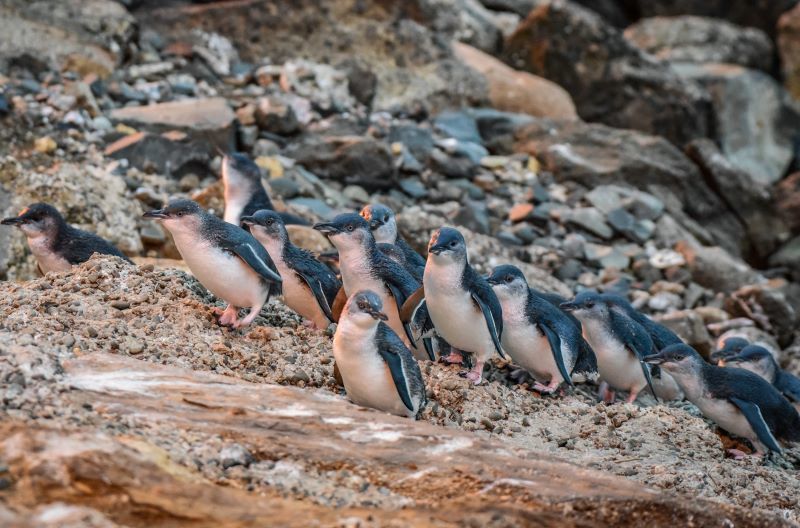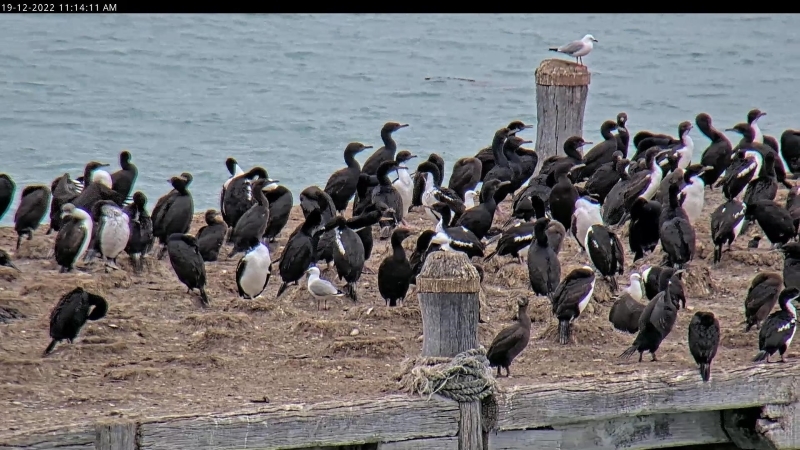Protecting, promoting wildlife has benefits for all
Ashley Smyth
10 January 2023, 5:30 PM
 Oamaru Blue Penguin Colony science and environmental manager Phillipa Agnew in front of Sumpter Wharf, where a camera is now operating to provide a 24-hour livestream of the Otago shags, viewable on YouTube. PHOTO: Ashley Smyth
Oamaru Blue Penguin Colony science and environmental manager Phillipa Agnew in front of Sumpter Wharf, where a camera is now operating to provide a 24-hour livestream of the Otago shags, viewable on YouTube. PHOTO: Ashley SmythOamaru’s wildlife is a major drawcard for the area which needs to be better looked after and understood, says Dr Phillipa Agnew. The Oamaru Blue Penguin Colony science and environmental manager sat down with Ashley Smyth to talk about Oamaru’s unique offerings, and why the tourist dollar is so important to the town and for the future of some of our rare birds. (4-minute read)
Protecting and promoting Oamaru's unique wildlife has benefits for everyone, Oamaru Blue Penguin Colony science and environmental manager Phillipa Agnew says.
A number of incidents had come to Dr Agnew’s attention before Christmas and prompted her to speak out about the importance of looking after the wildlife surrounding this area, not only to protect the animals, but also for the Waitaki tourism industry.
In one incident, Dr Agnew was aware of a number of shags and their chicks being scared into the water off Sumpter Wharf, in Oamaru’s harbour.
“Those chicks aren’t able to fly - they’re covered in down - so get really cold, really quickly. They swim to the shore, and then they can’t get back onto the wharf to be fed,” she said.
A group of people spent several hours putting the chicks back onto the wharf and Dr Agnew was working with the Waitaki District Council to improve the signage there.
“I think that comes because of people not realising the damage that they’re doing.”
About 15 dead seagulls found on the foreshore just off Humber St, had been sent away to determine how they died, but it was potentially suspicious.
Also, a new red-billed gull colony situated on Cape Wanbrow, had been disturbed by fishers, who walked right through the middle of the nesting site.
“These birds have all got chicks that are either a week or two old, right up to near fledging, so there’s hundreds of birds around there, and that level of disturbance in a brand new colony could be really bad for those birds,” she said.
The new colony was good news for local building owners, who had been plagued by the gull population in recent years, with the numbers of birds at the new site directly correlating to the reduction of the number of birds in the town.
“So we’re hoping that they’re going to be moving into that more natural space,” Dr Agnew said.
There were two fences blocking the disused Department of Conservation track, one with signage which alerted people to the gulls nesting.
“We’re trying to encourage them to be somewhere not on the buildings, so this is a really positive thing and it’s really sad that people don’t see how important it is.”
Other disturbing stories Dr Agnew had heard were of somebody throwing stones at a fur seal on the breakwater, and also of a person picking a live penguin up in the harbour, carrying it inside the Sports Central Brewhouse on Wear St, before taking it back outside where it bit him, and he dropped it.
“I mean, that level of stress is massive for that bird,” Dr Agnew said.
“So it’s all just a little bit disappointing really, that there’s so many instances of people just disrespecting wildlife and them not sort of seeing the value. Because it’s so important to this town.”

The blue penguin population has increased year on year since monitoring began at the Oamaru colony in 1993. PHOTO: Supplied
Promoting colony helps penguins and community
The penguin colony is one of several “business units” under the council-controlled organisation Tourism Waitaki Limited.
Revenue received from ticket sales had driven the development of the colony, and any profits went towards supporting the work Tourism Waitaki did to market the region, Dr Agnew, who is also the Tourism Waitaki acting general manager, said.
“So all of the infrastructure you can see, I mean it’s all supported by that revenue that we’ve had coming in, and then so we’ve got all these amazing things that we’ve been doing over the years.”
Monitoring had been carried out since 1993, and predator control, provision of nesting and habitat, a rehabilitation facility, a road underpass, further research, and new weigh platforms had all added value to the facility over time.
There was a huge investment in the wellbeing of the animals, and it was showing in the population trends, Dr Agnew said.
“This population is increasing every year by around 8-9%, so at the beginning there were 33 breeding pairs, and now we’ve got 279, and we study a second colony as well.”
The second colony was between Holmes Wharf and Oamaru Creek, and had been set up as a control colony to monitor the impacts of tourism on the penguin population. The results showed the colonies tracked “very very similarly”, which meant, managed well, tourism did not have a negative impact.
“We’ve got the boardwalks and the viewing stands, but that helps us control where the people go - not the penguins. The penguins come and go naturally and that’s how we manage disturbance, is by having that structure in place.”
This was the reason it was important to support the regulated tourism operations, especially for international visitors coming to the town.
A lot of locals knew how to act around New Zealand wildlife, but international tourists didn’t necessarily, she said.
“That’s really why I get upset about people sending overseas visitors, or visitors in general to see penguins for free, because they don’t realise if they do that to everybody, there is going to be a serious impact on those penguins.
Also, these overseas visitors, they’ve come to Oamaru, probably to see the penguins, so they want the best experience possible, and most of them are happy to pay, and the quality of the experience they can get with us is vastly better than what they’ll see chasing penguins that are scared, outside of the boundary.”
Before the viewing platform and information centre was built at the colony, there was very little infrastructure. The colony had grown because of the investment that had been made, and in turn, this is why the penguin population is thriving.
“And because they are thriving in here, that’s why there are penguins outside of our boundary - that’s the only reason. So if none of this existed - there would be no penguins here.”
New livestreaming
Now fans of not just the penguins, but the Otago shags, which congregate on Sumpter Wharf, can watch them 24/7 on YouTube.
The shags are only found in Otago, and the wharf had been home to as many as 650 nests at one time, making up almost half of the entire species, Dr Agnew said.
“So it’s a really important site.”
The shags nest on the wharf and raise their chicks, and had done so for close to 10 years.
“If something happened to that wharf and all of those birds died, that’s half that species gone.”

A still shot from the livestream camera filming at Sumpter wharf which is available 24/7 on YouTube. PHOTO: Supplied




